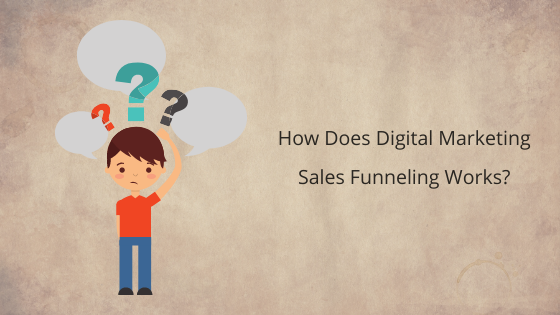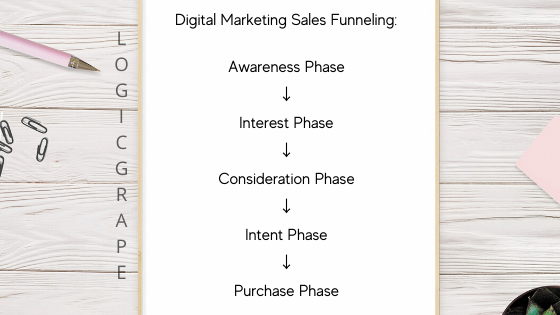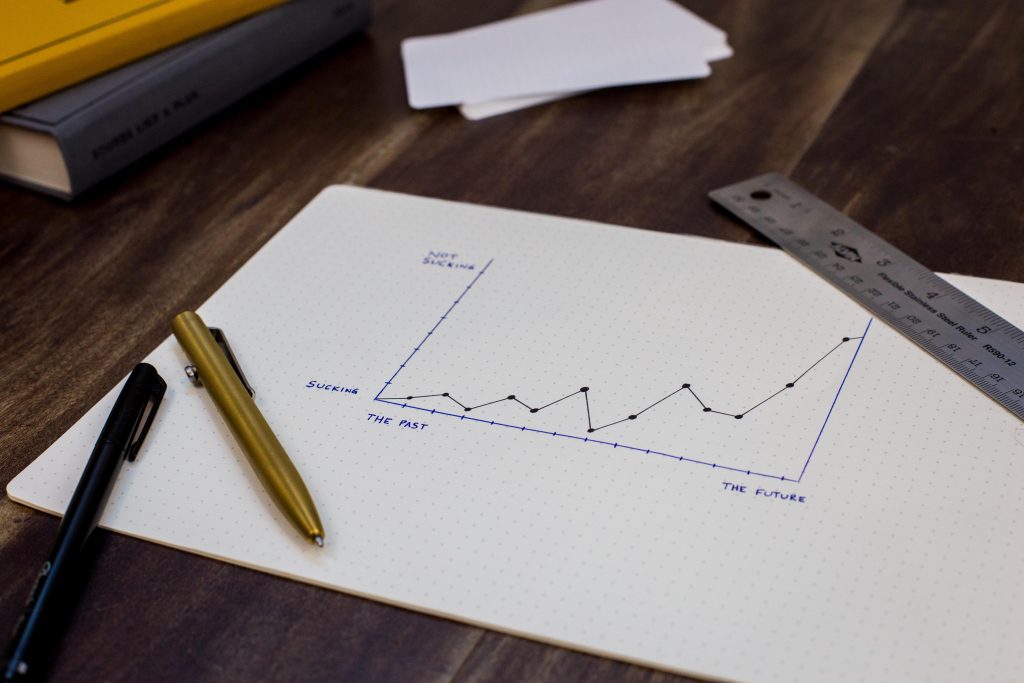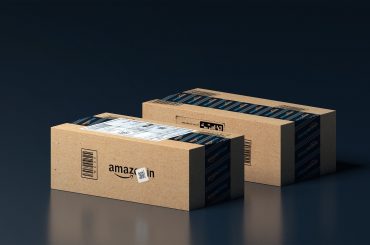Strategies are a long-term plan of action that plays a pivotal role in any sort of activity to achieve a particular goal or set of objects. Digital Marketing Sales Funneling is one of the tools that is used by businesses for attaining goals, i.e. generating leads and sales. It is a visual representation for understanding the whole process of converting leads into customers.
Marketing Sales Funneling in Digital Marketing is a process of compartmentalizing the customer’s journey from the “awareness” stage, i.e. when the customer first gets to know about business from various sources to the “purchase” stage, i.e. when the customer has made the purchase. It is called a funnel because the inverted shape represents how leads drop off along the way to converting into a customer.
How Does Digital Marketing Sales Funneling Work?
The reason behind using the word funnel is that marketing can not nurture all the leads into a customer. So, they have to sort of filter to get customers from the process, with efforts to get maximum out of it.

Alike, traditional marketing, Digital Marketing also does not follow a linear set of the process. Businesses can’t approach for conventional marketing in the digital market. Every user takes a different path to know about the company. Also, traditional strategy can’t do any good to the business as it could restrict the reach.
Different Strategies of Digital Marketing Sales Funneling
Businesses have used various paths or strategies as per the category of customers they require.
Few paths are mentioned below:
- Hourglass Digital Marketing Funnel
- Lopping Digital Marketing Funnel
- Micro-Moments Digital Marketing Funnel
Not all businesses need to follow a particular set of funnel strategies. Companies decide their digital marketing funnel strategy as per their domain or industry’s nature.
Digital Marketing Sales Funnel is essential in all kinds of businesses. With analysis and mapping every stage of a customer’s journey, a company can get valuable insights.
Insights gained from sales funnelling in digital marketing can help to optimize the process for a better conversion rate and providing transparency. Also, it gives the outline of which stage needs a better approach to convert leads into a customer.
How Can Digital Marketing Sales Funneling Help?
There is always competition and additionally, digitalization. Also, there is a requirement of new and innovative ways every single day to compete in the market. Hence it leads to modification of approach, into a more creative and innovative one.

An effective digital marketing funnel helps businesses in multiple ways, such as:
- Data insights at every stage of consumer behaviour.
- Depending on process automation, it saves time and improves efficiency.
- Process automation leaves a lesser chance of errors.
- Contributes to the improvement of brand value and awareness.
Transition From Traditional to Modern Marketing Strategies
The consumer doesn’t use a linear path as happens in traditional marketing to purchase products or services in digital marketing. So, because of the presence of the internet, different strategies are being used.
The internet makes horizons wider for everyone. People can then have access to a vast amount of information. However, the internet is flooded with numerous things such as blogs and reviews on products or services, that can impact customer behaviour very effectively.
The fundamental approach for the traditional and modern funnel is the same, i.e. converting leads into loyal customers. However, the approaching customer is not uniform anymore. It has become dynamic, digital, and multi-faceted. The modern approach can’t be restricted to one model theory.
Traditional funnel conforms to universal user behaviour (which is monotonous) while digital funnel concentrates on action driving the user.
Stages of Digital Marketing Sales Funneling
Digital Marketing Sales Funnel consists of 5 stages; each of them has its purpose. Here are them:

- Awareness Phase
- Interest Phase
- Consideration Phase
- Intent Phase
- Purchase Phase
Awareness Phase
Awareness Phase is the uppermost stage of the funnel. In this stage, leads are generated by making them aware of the brand through different digital campaigns. Businesses can achieve them through blogs, videos, events, emailers, etc.
Awareness Phase is the most important and focused part of the digital marketing sales funnel.
“More the leads, more the chances of conversion.”
Interest Phase
Interest Phase comes after the procurement of leads. The aim of this phase is to cultivate an interest in prospects for the sale of the company’s product or service.
In the Interest Phase, leads start showing interest to know more about the products. Over here, there is an excellent opportunity for companies to get a sale. Marketers start to nurture leads to make them the prospect through engaging content on social media and the website.
Many times, companies use strategies like putting offer banners and previous reviews on the platforms. It helps in creating trust among the leads. Ultimately, the “trust factor” works as the most successful way to funnel leads forward.
Consideration Phase
In Consideration Stage, leads are qualified as a prospect. And marketers start investing more time on them by using content about products and offers. Tries to convince them to make a purchase.
Also, while continuing to nurture them with targeted content, case studies, free trials, and more, they try to gain the trust of prospects for increasing customer loyalty.
Intent Phase
Prospects in the intent stage indicate that they will make a purchase or contact representatives from the website.
Prospects here start creating a mindset to purchase the product or service. Here marketers focus on the least loss of them for any reason.
Also, marketers can analyze why their product has been chosen over others and try to be consistent about it. And also, why the prospects dropped out, to optimize the strategy for minimizing the loss.
Evaluation Phase
In the evaluation stage, potential customers make the final decision for whether they should buy the product or services or not.
Marketing and sales work together very closely to nurture the decision-making process and influence customers.
The goal here for companies is to convince the buyers that the product or service is the right choice.
Purchase Phase
Purchase Stage is the last stage in the funnel. Here the potential customer will turn into a customer after making a purchase. Before this stage, there was more probability that the potential customer may bail because of some reason. While in this stage, there are fewer chances for customers to bail out.
Companies focus on eliminating every reason why a potential customer drops out from here.
The leading causes for drop-outs that are seen in B2C companies are server response delay, slow site load speed, and lack of informational content on the checkout page.
Digital Marketing Sales Funneling For B2C & B2B Companies
Let’s go through B2C and B2B consumer action and conversion in each stage of the funnel:
Awareness Phase
Both B2C and B2B search for information in this stage. So, there is no much difference in the way they both funnel in the awareness stage.
Interest Phase
In this stage, the digital marketing sales funnelling approach between B2B and B2C starts to differ. In B2C, leads learn about the products from platforms, while in B2B leads examine specific products and reviews.
Consideration Phase
In this stage, B2C read reviews and compare products and B2B share research on products and brands with other stakeholders.
Intent Phase
In this stage, B2C targets that customers click on checkout or such a relevant button. While in B2B, companies target that they get more clicks on product-demo or a corresponding button.
Evaluation Phase
In this stage, B2C review shopping experience and go to check out, and B2C gets the contract proposal.
Purchase Phase
In this stage, the process comes to an end, and the final process becomes the same in a B2C sales transaction is completed, and in B2B sales transaction is completed.
Key Differences
Most B2C go across the funnel alone or with trusted people in a small group ( family and friends ). On the other hand, B2B companies usually have larger cross-departmental buying groups.
In a normal process of purchasing excluding the customer service part, B2C may never directly interact with the company or sales representative. In contrast, B2B usually interacts with the company or sales representative at the lower end of the funnel.
Maximize Reach in All Stages of Digital Marketing Sales Funneling
We are living in a world that is highly dependent on the internet. And internet marketing depends on things such as social media, e-commerce, digital marketing, etc.

With the modern funnel approach, there are numerous Digital Marketing Sales Funnels. It sometimes becomes complicated to settle on one funnel approach. Eventually, the thing that matters is whichever funnel used it should help to reach the goal and maximize reach and profit.
5 Key to Maximize Reach With Digital Marketing Sales Funneling:
- Assistance of 24/7
- Focus on more than metrics
- Use Artificial Intelligence
- Leverage brand value
- Market to your ideal shopper
Digital Marketing Sales Funneling in SEO
SEO (Search Engine Optimization) is the best way to get leads. And to get maximum out of it, businesses need to plan strategies accordingly.
Awareness Phase in SEO – Impression
Awareness Phase lies at the top of the funnel, the objective is to capture numerous traffic. So, by focusing on keywords can help to attract more traffic as it improves SEO (Search Engine Optimization) ranking, content should be geared around the types of search queries the user has.
Websites should use effective SEO. It can help them to attain top ranking on SERP to get more impressions.
Interest Phase in SEO – CTR
CTR (Click Through Rate) is the percentage of people who have clicked on websites after seeing it. The objective of the interest stage is that users should feel that the search queries can resolve.
Businesses should try to focus on getting good CTR because, between Awareness and Interest phase, the loss of leads is maximum.
Decision Phase in SEO – Contact
Decision Phase is a crucial stage in SEO. Here, users get convinced that the company has a solution for their queries and requirements, and it’s the right solution to their problem.
Webpage should be convincing enough to make the visitors trust the brand and make them turn into a potential customer. Moreover, a well-designed site can be useful in transforming prospects into potential customers.
Action Phase in SEO – Purchase
In this stage, potential customers become customers, i.e. they have made the purchase. However, Losing potential customers at the bottom of the funnel signifies that the website requires improvements. Converting potential customers to a customer is the success of a business. And the companies should try their best not to lose a customer in this phase.
While browsing how feasible is the website also plays a significant role in customer’s decisions of purchasing or accessing the service from the sites.
Strategies are a long-term plan of action that plays a pivotal role in any sort of activity to achieve a particular goal or set of objects.
Conclusion
Digital Marketing Sales Funneling is a basic need of every business if they want to get good ROI. However, making a good digital marketing funnel strategy requires both experience and expertise. Huge and small enterprises hire digital marketing agencies for planning and managing them.





1 Comment
Pingback: 5 Steps To Create A Digital Marketing Strategy - LogicGrape Blog